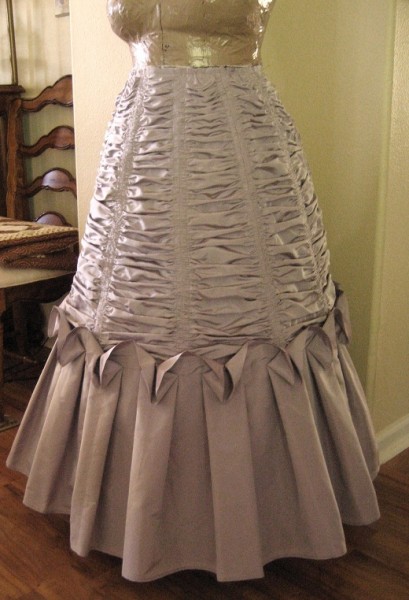
It’s not exactly swimming but I feel I’ve been drowning under miles of lavender taffeta. The 1873 purple gown is made of awesome ruched panels that are glorious in all their puffiness.
You’d think running a few rows of basting stitches then pulling them up and sewing down to a base wouldn’t be all that hard.
Hard, no. A monster that eats up your precious sewing time, yes.
The entire skirt base is made from Truly Victorian 201 – 1870s Underskirt, in a black cotton twill. The front apron pattern was then taken from the base pattern. Here I traced the base pattern, moved seamlines then added lines to cut & spread the apron base to add for the gathering. The apron has seven sections, each with three rows of gathering mounted onto a base of center front and two side fronts.
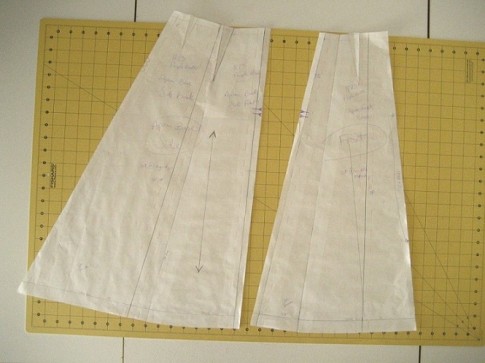
The silk pattern before slashing:

I’ve spent lots of time discecting the 1 photo and flat sketches of the V&A dress in Nineteenth Century Fashion in Detail. It’s all that’s available to go off of so I’m kinda making it up as I go along. After playing with a large swatch of the silk taffeta I decided to go with 2x the length of the base for my gathered silk.
The left is 1.5x the length and 2x is on the right.
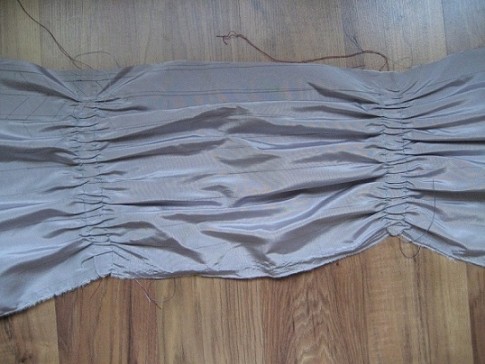
The original has a center front and two sides you can see in the photo and I debated on either doing the same or sewing the side seams first and mounting the whole ruched apron onto the base. But as I was pulling those gather threads I realized how much more practical it was to ruche each panel separately.
The Victorians got it right, here.
So after much time running in the basting stitches and ruching, ruching, ruching, I got one panel done. Each panel was mounted first to a organdy base to hold the gathers in place.

Then the others followed and I sewed the final side seams. The whole apron was then mounted to the twill underskirt front section.
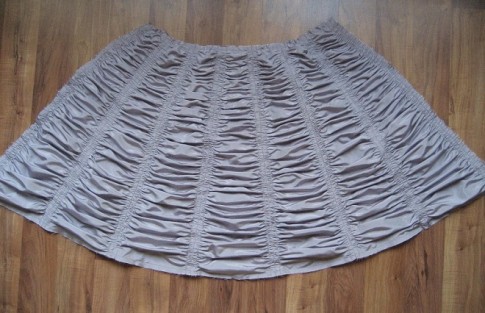
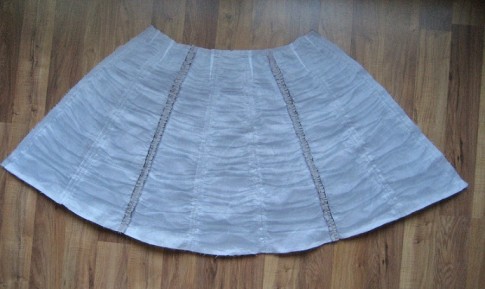
But alas, my ruching is not done. Nope. I still have the back panel deep ruffle to go. It has 3 sets of three rows of gathering lines. -sigh-
Here is the the first section being ruched and pinned to the taffeta skirt back panel.
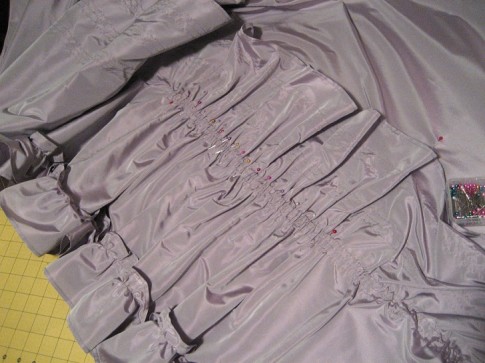
So I just keep ruching, ruching, ruching until that ruffle is on.
Did I mention I have to gather the top of the back panel to make the bustle poufs? Maybe the dress should be called the Ruche Monster…
(You can see the finished dress here.)
(And the finished dress with the day bodice here.)


I love this lavender gown. I want to do the same from, but with a more Victorian bustle back. I was wondering how much fabric each ruched panel took. Your website here has so much beautiful and helpful information. Thank you for sharing your talents and knowledge with us.
I actually don’t have the exact yardage for the panels. I can tell you, though, that I used about 10 yards of 54″ silk taffeta for the full ruched skirt (back panels, ruffles, front ruched apron panels and lower ruffle) as well as an evening bodice (with ruched yoke) and day bodice with long sleeves. So, maybe, about 7 yards for the whole skirt???
And thank you for continuing to follow me. It’s a joy to hear my work has benefited so many. <3
I’m still a little leery of what looks like more work (spelled; frustration/swearing) than I can handle, but this gown was really beautiful. It was one of the few times I wished the line for pictures was slower so we could take more time to analize how you did the top edge of those skirt pleats. FABULOUS Looking!!
THis is absolutely beautiful 🙂 And I love the name of the dress. I’ve just found your website – it’s terrific.
am i understanding correctly that the front of the skirt is actually 3 layers of fabric? wow
Yes: the ruched silk is mounted onto an organdy base then the whole of that is mounted to the cotton twill underskirt base. The box pleated ruffle is then sewn over the bottom of the apron directly to the underskirt.
The apron lines are 1/2″ apart. Made it easy with my 1/2″ seam allowance. I ruched at the 1/2″ SA line and 1/2″ away from that. When I sewed the panel seams, the seamline ruching matches and looks uniform with the same 1″ width of the other gather lines.
All three panels were completely ruched and mounted separately onto the organdy before they were sewn together to make the apron.
Jennifer – 2x is a good ratio – though I have used 3x on heavier fabric (the pink satin I wore to the Assembly Hall in Bath). to join your panels, did you join and then ruch the seamed panel line? since you are mounting it on a base, that should work well.
WOW! I’m deathly afraid of ruching, but you’re making it look easy and beautiful. Plus I love that you’ve named it “blackberry and cream dress.” I think all gowns should be named after food 🙂